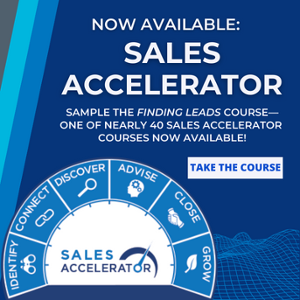
Some people are skilled at closing a sale. It's easy for them to build rapport with customers, gather information, pitch a product or service, and then close the sale. Others excel only in connecting with prospects and find it incredibly hard to present a product or close the sale.
Utilizing a sales process can help salespeople become better at what they do. In this article, we cover the basics of the sales process and teach you how to improve sales performance.
Step 1: Identify — "Prospect,” “Select,” or “Find"
 The first step to the sales process is about selecting potential leads. At The Center for Sales Strategy (CSS), we call this Identify, but it's also called prospecting, this step involves qualifying leads to help you determine if they're the right customers. It's a crucial step as it tells you whether or not the lead will eventually convert to a sale.
The first step to the sales process is about selecting potential leads. At The Center for Sales Strategy (CSS), we call this Identify, but it's also called prospecting, this step involves qualifying leads to help you determine if they're the right customers. It's a crucial step as it tells you whether or not the lead will eventually convert to a sale.
To qualify leads, you'll need to ask the right questions.
-
Are they interested in what you're selling?
-
Do you have what their business needs?
-
Can they afford to purchase your products and services?
-
Are you talking to the decision-maker of the company?
Pursue a lead that meets all the criteria or leads that will or may buy from you. Otherwise, let go of the lead and move on to another. Try not to waste your time with unqualified leads hoping they will buy in the future. You can maximize your time when you only pursue qualified leads.
Cold leads — or those customers who are interested in buying but not ready yet — consider pursuing them at a certain time in the future.
Move forward with the hot and warm leads — and you must nurture these so they're more likely to buy from you.
Step 2: Connect — "Approach,” “Engage,” or “Plan”
In this step, you'll use insights to develop a valid business reason and build rapport with your potential customer. This involves building trust and credibility.
It's unlikely for a customer to buy from someone they don't trust, so start building rapport with them and connect on a deeper level. Get to know your customers well and ask the right questions.
Before calling leads, you should already know who your target audience is. Knowing your target market is effective in helping you find the best approach or strategies to connect with them effectively.
Plan how you want to engage with your potential customers. If you did your research, it should be easier to ask the right questions about their business. Ensure that you share with them relevant information about your company. This is how you build trust. As much as possible, stay firm and confident about what you are offering.
It may take a couple of calls before you can get them to listen to you. You'll succeed if you don't give up right away; it would help if you are knowledgeable about what you are offering and who your target audience is.
The bottom line is: When calling, make it a goal to always offer something with value and don't just check in.
Step 3: Discover — "Define,” “Assessment,” or “Needs”
The next step is about discovering what your potential customer needs. It's an important step as it helps you determine what type of product or service to offer them. Ensure that you know and understand their challenges so you can establish the most effective solutions for them.
The Discover step involves more research on your potential customer. Go the extra mile by doing more than just reading about their company. Consider speaking with other employees to help you find out what their business objectives are. Stay curious about your customer and gather more information about their business. This would help you find out what solutions to recommend to them.
Step 4: Advise — “Solve” or “Create”
"Advise" comes after qualifying leads, establishing a connection, and knowing what their objectives are. This step involves a product or service demonstration that is fit for your customer's needs.
This may take a lot of your time as you'll need to discuss how beneficial your recommendations are to the company and how it would help them achieve their business objectives. Be as detailed as possible when recommending the best solution to them. Try to sound firm and confident in recommending solutions.
Be prepared beforehand. Your customers will have objectives. You should be able to address all of them with confidence in what you're offering.
Step 5: Close — "Confirm,” “Agreement,” or “Present"
After pitching the right product or service, don't hesitate to ask for the sale. Some salespeople are great at pitching and not so good at closing the sale. Others don't even ask for the sale; they wait for the customers to say they're ready to move forward.
Always — and we mean all the time — ask for the sale. As much as possible, create a sense of urgency, so they feel compelled to buy from you. However, stay upbeat but not too salesy.
Step 6: Grow — "Retain" or "Deliver"
The last step of the sales process isn't closing the sale; it's keeping your promises and growing the account.
It would help if you delivered what was promised to the customers. Better yet, aim to exceed expectations. Do you know what's going to happen when the solutions you recommended worked? You'll get repeat businesses. Your clients will recommend your business to others. It can help generate more revenue for your company.
Now that we've discussed the sales process, it's important to know how to improve it and maximize profit.
How to Improve the Sales Process
It can be overwhelming to have hundreds, or thousands, of leads. You'll find it difficult to find which leads are ready to purchase and which ones still need more nurturing. While Excel can help, it may not be that effective in improving the sales process.
This is where the Account List Management Strategy (ALMS) comes in. With this tool, you'll know which accounts to prioritize and which accounts still need more nurturing. An ALMS is who your salespeople spend time on. Once you have the right sales structure and a quality sales process in place, and ALMS provides a solid framework to manage all of your accounts.
Incorporating a CRM also helps. Customer Relationship Management (CRM) can elevate an organization's ailing sales process. The system is equipped with a variety of tools that helps a company manage their leads better and provide an accurate sales forecasting.
To better improve the sales process, the sales manager must analyze their current process and strategies in generating more income for the company. If the current process doesn't contribute to more revenue, it's time to review everything.
Determine the buyer's journey for your target prospects so your sales rep can better empathize with them. You'll need to find out what makes them move forward to the next step and how you can give them a better experience.
Taking advantage of effective tools and communication will help minimize mistakes in the sales process. In the next section, we'll talk about the common mistakes in the process.
Sales Process Common Mistakes
You're bound to make mistakes before you can perfect the sales process. There are things you can do to alleviate problems and avoid mistakes.
Focusing on the Wrong Lead
One of the most crucial steps is to qualify your leads better. Hot leads and warm leads are likely to convert to a sale. Cold leads will need A LOT of nurturing from the salesperson. Some leads don't qualify, and salespeople sometimes make the mistake of pursuing this type of lead. If they're not the decision-maker, it'll be impossible to close the sale. Move on to another lead when you're not able to get ahold of the company's decision-maker.
Not Following the Sales Structure
To increase your chances of getting a sale, you can't just recommend solutions to the prospect without finding out their problems. Knowing your prospects' objectives and pain points will be easier for you to recommend the best solutions.
You must start with the first step — identify the high potential accounts, connect, discover, advise, close and deliver what was promised.
How to Measure Effectiveness of your Sales Process
The only way to find out if your strategies work is by measuring them. After making sure everyone follows the sales process, you'll need to identify your sales metrics. The metrics should align with the company's main objectives.
Some of the metrics you need to measure include the sales quota, annual targets, sales growth, product performance and lead conversion rate. The metrics depend on the goals of each organization.
You'll know the process works when you're able to achieve your business objectives. Some of your salespeople may need additional coaching for them to become more productive. Invest in educating your salespeople and helping them enhance their skills.
Don't forget to check all of our resources to help you improve sales performance.










